- Home
- About Us
- Industry
- Services
- Reading
- Contact Us
Biopellet Energy Market: Current Analysis and Forecast (2024-2032)
Emphasis on Type (Pellet Stoves, Boilers, and Burners); By Application (Heat Generation, Power Generation, Combined Heat and Power (CHP), and Others); By End-User (Industrial, Residential, And Commercial); Region/Country
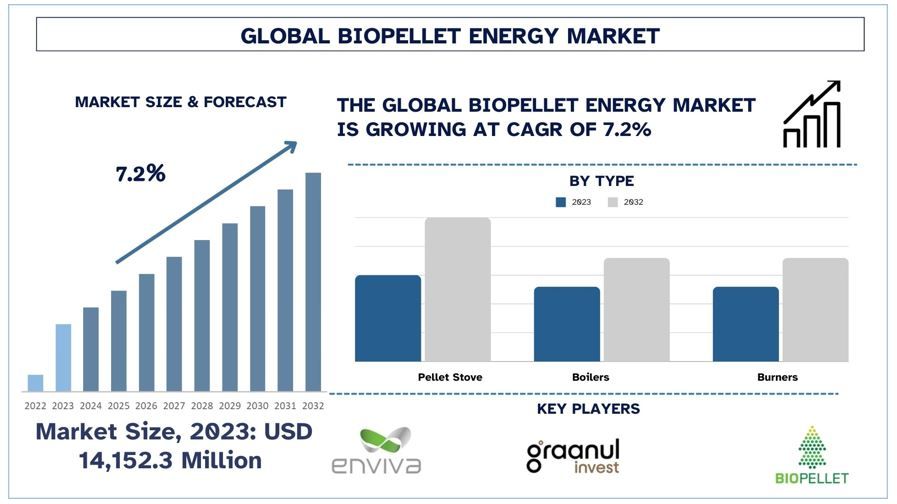
Biopellet Energy Market Size & Forecast
The Biopellet Energy market was valued at 14,152.3 million in 2023 and is expected to grow at a CAGR of 7.2% during the forecast period (2024-2032). Biopellet energy is energy produced from pressed biomass pellets and often obtained from organic resources such as timber, farm produce waste, or any other renewable material. These pellets are employed for use as biofuels, which are environmentally friendly and suitable for use as a substitute for non-renewable fossil fuels in the generation of heat and electricity. Biopellet energy is economical, and sustainable, and contributes to cutting greenhouse emissions. This alternative is integrated into residential, industrial, and power generation applications due to the increasing world trend of embracing renewable energy sources. Thus, the driving forces of biopellet energy are the growing incentives towards renewable energy by the government and the carbon emission regulation that forces industries and homes to switch to clean energy sources. Furthermore, there is improvement in pellet production and combustion technology that increases efficiency hence making the Biopellets cheaper.
Biopellet Energy Market Analysis
Governments across the globe are urging the utilization of renewable energy sources for climate change mitigation, which increases the demand for the biopellet energy market. Those factors include subsidies, tax credits, and renewable energy mandates that lower the operational cost thereby enhancing market access. European countries spent over €6.3 (USD 6.95) billion on subsidies for bioenergy in 2021–more than any previous year and an almost 33% increase from 2015.
Moreover, international regulations such as the Paris Climate Accord apply pressure on nations to reduce emissions of carbon, which makes countries look forward to using cleaner energy sources including biopellet. The goals of the Paris Agreement, by 2030, zero-carbon solutions could be competitive in sectors representing over 70% of global emissions.
Government policies have a significant impact on the development of the biopellet energy market because of having provided proper legal conditions. Such policies include subsidies, tax incentives, and grants that enable the minimization of the cost of production and propensity of biopellet technologies. Furthermore, renewable portfolio standards and carbon dioxide pricing policies force industries and consumers to opt for cheaper and renewable energy such as biopellet.
Biopellet Energy Market Trends
Rising Exports to Europe and Asia:
The bio-pellet energy market has experienced increased export-oriented trends, especially in European and Asia markets, which has increased the general demand for sustainable energy solutions. This rise can be attributed to the rising need to adopt green power since many policymakers and companies are aspiring to embrace clean energy sources in place of conventional hydrocarbon resources. Europe has stricter climate targets and has an existing built structure for bioenergy imports large amounts of bio pellets while Asia, being the rising economy and with increasing demand for energy and climate change commitments has imported large amounts of these fuels. This movement supports the global trend that concerns the change towards clean and sustainable energy production and demonstrates how the application and market of bio pellets is becoming more and more important for the international energy sector. For instance, according to the United States Department of Agriculture’s Foreign Agricultural Service, in 2022, Europe’s wood pellet consumption hit a new record of 24.8 million metric tons (MMT) mainly due to increased residential use. In 2022, Europe wood pellet imports totaled 5.89 MMT with a value of USD 1.32 billion. The EU adopted an import ban for wood pellets from Russia in the summer of 2022 has created an opportunity for the transatlantic trade of wood pellets.
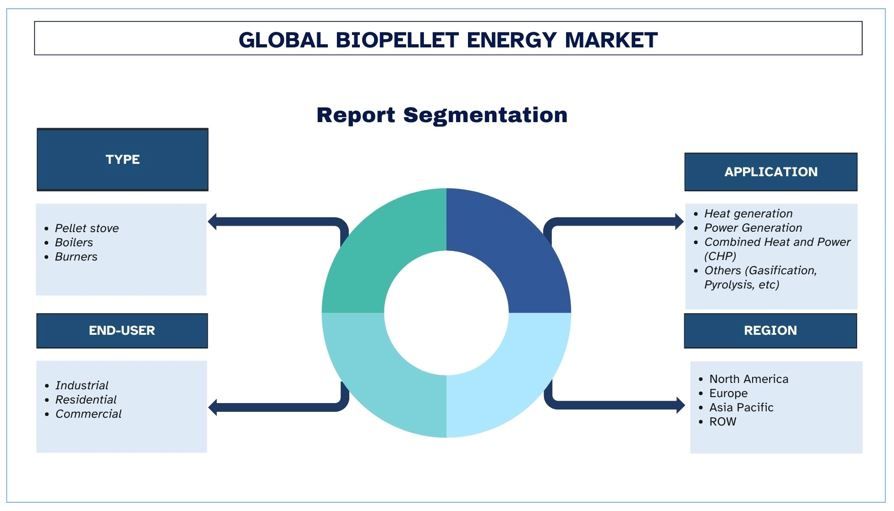
Asia Pacific is Expected to Grow with Significant CAGR During Forecast Period
Asia-Pacific has significantly contributed to the expansion of the Biopellet Energy market. The market for bio pellet energy is rapidly growing, especially in the Asia-Pacific region due to the growing energy needs combined with the effects of global warming in the region, and favorable government policies. With the increasing awareness of the reduction of reliance on fossil energy and integration of renewable energy sources in the countries of this region, bio pellets have been identified as suitable energy products. Major drivers of this growth include the huge capital expenditure on bio pellet production facilities, innovative technologies, and supportive policies on utilizing renewable energy. Furthermore, awareness of climate change and sustainable energy is increasing, reducing the adoption rate of bioenergy adoption. The Asia-Pacific region holds significant biomass resources and is experiencing a surge in energy demand, positioning itself as a key driver of growth in the bio pellet market towards achieving the region’s renewable energy goals.
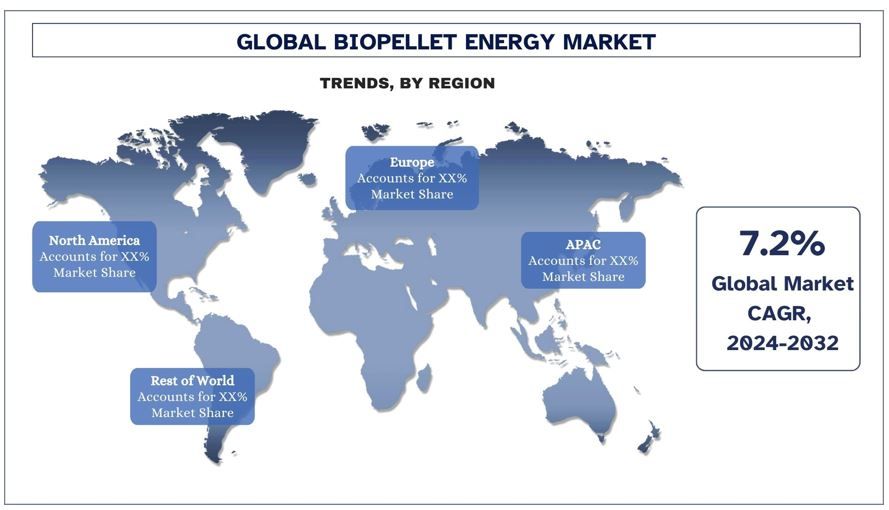
Biopellet Energy Industry Overview
- The Biopellet Energy market is competitive and fragmented, with the presence of several global and international market players. The key players are adopting different growth strategies to enhance their market presence, such as partnerships, agreements, collaborations, new product launches, geographical expansions, and mergers and acquisitions. Some of the major players operating in the market are Enviva Inc., AS Graanul Invest, UAB BIOPELLET, BioPower Sustainable Energy Corporation, Abellon Clean Energy Limited, Drax Group plc, Biomass Secure Power Inc, Highland Pellets, LLC, Sinclar Group Forest Products. and BIOENECO SDN. BHD
Biopellet Energy Market News
- In 2024, Ashmore Group plc announced the acquisition of a majority stake in BIOENA S.A.S. (“Bioena” or the “Company”), via its third private equity fund in Latin America, Fondo Ashmore Andino III – FCP and Ashmore Andean Fund III, LP, managed by its subsidiary Ashmore Management Company Colombia (“Ashmore Colombia”). Bioena is a pioneering Colombian company dedicated to the production and commercialization of industrial wood pellets, holding the distinction of being the first company to develop wood pellet production in Colombia.
- In 2024, Drax Group acquired the Princeton Standard Pellet Corporation (PSPC) pellet plant in Princeton, Canada that aims to produce and supply pellets to third parties in Asia and Europe as they displace fossil fuels from energy systems.
Biopellet Energy Market Report Coverage
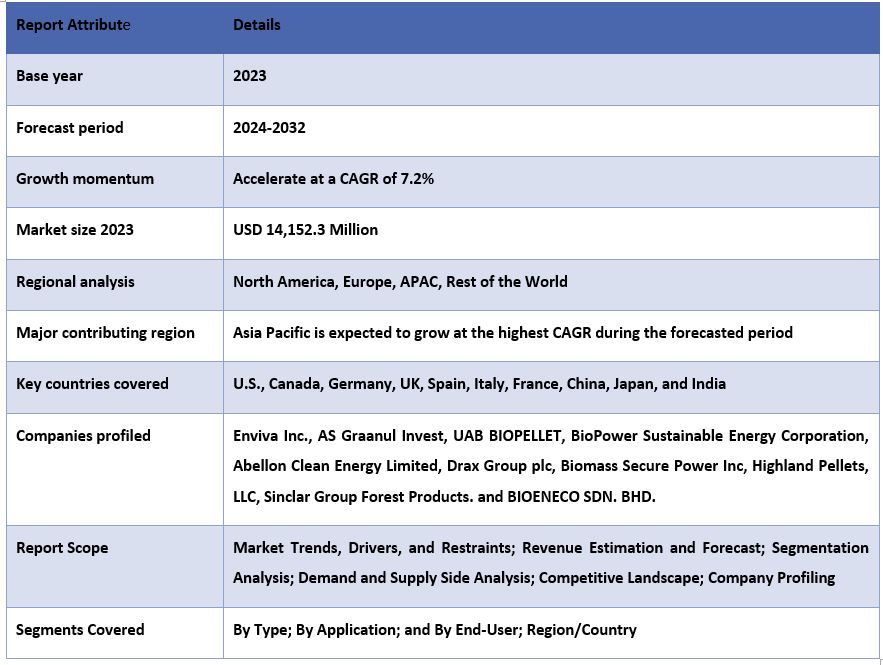
Reasons to buy this report:
- The study includes market sizing and forecasting analysis validated by authenticated key industry experts.
- The report presents a quick review of overall industry performance at one glance.
- The report covers an in-depth analysis of prominent industry peers with a primary focus on key business financials, product portfolios, expansion strategies, and recent developments.
- Detailed examination of drivers, restraints, key trends, and opportunities prevailing in the industry.
- The study comprehensively covers the market across different segments.
- Deep dive regional level analysis of the industry.
Customization Options:
The global Biopellet Energy market can further be customized as per the requirement or any other market segment. Besides this, UMI understands that you may have your own business needs, hence feel free to connect with us to get a report that completely suits your requirements.
Table of Content
Research Methodology for the Biopellet Energy Market Analysis (2024-2032)
Analyzing the historical market, estimating the current market, and forecasting the future market of the global Biopellet Energy market were the three major steps undertaken to create and analyze the adoption of Biopellet Energy in major regions globally. Exhaustive secondary research was conducted to collect the historical market numbers and estimate the current market size. Secondly, to validate these insights, numerous findings and assumptions were taken into consideration. Moreover, exhaustive primary interviews were also conducted, with industry experts across the value chain of the global Biopellet Energy market. Post assumption and validation of market numbers through primary interviews, we employed a top-down/bottom-up approach to forecasting the complete market size. Thereafter, market breakdown and data triangulation methods were adopted to estimate and analyze the market size of segments and sub-segments of the industry pertains to. Detailed methodology is explained below:
Analysis of Historical Market Size
Step 1: In-Depth Study of Secondary Sources:
A detailed secondary study was conducted to obtain the historical market size of the Biopellet Energy market through company internal sources such as annual reports & financial statements, performance presentations, press releases, etc., and external sources including journals, news & articles, government publications, competitor publications, sector reports, third-party database, and other credible publications.
Step 2: Market Segmentation:
After obtaining the historical market size of the Biopellet Energy market, we conducted a detailed secondary analysis to gather historical market insights and share for different segments & sub-segments for major regions. Major segments are included in the report as a type, application, and end-user. Further country-level analyses were conducted to evaluate the overall adoption of testing models in that region.
Step 3: Factor Analysis:
After acquiring the historical market size of different segments and sub-segments, we conducted a detailed factor analysis to estimate the current market size of the Biopellet Energy market. Further, we conducted factor analysis using dependent and independent variables such as type, application, and end-user of the Biopellet Energy market. A thorough analysis was conducted of demand and supply-side scenarios considering top partnerships, mergers and acquisitions, business expansion, and product launches in the Biopellet Energy market sector across the globe.
Current Market Size Estimate & Forecast
Current Market Sizing: Based on actionable insights from the above 3 steps, we arrived at the current market size, key players in the global Biopellet Energy market, and market shares of the segments. All the required percentage shares split, and market breakdowns were determined using the above-mentioned secondary approach and were verified through primary interviews.
Estimation & Forecasting: For market estimation and forecast, weights were assigned to varied factors including drivers & trends, restraints, and opportunities available for the stakeholders. After analyzing these factors, relevant forecasting techniques i.e., the top-down/bottom-up approach were applied to arrive at the market forecast 2032 for different segments and sub-segments across the major markets globally. The research methodology adopted to estimate the market size encompasses:
- The industry’s market size, in terms of revenue (USD) and the adoption rate of the Biopellet Energy market across the major markets domestically
- All percentage shares, splits, and breakdowns of market segments and sub-segments
- Key players in the global Biopellet Energy market regarding products offered. Also, the growth strategies adopted by these players to compete in the fast-growing market.
Market Size and Share Validation
Primary Research: In-depth interviews were conducted with the Key Opinion Leaders (KOLs) including Top Level Executives (CXO/VPs, Sales Head, Marketing Head, Operational Head, Regional Head, Country Head, etc.) across major regions. Primary research findings were then summarized, and statistical analysis was performed to prove the stated hypothesis. Inputs from primary research were consolidated with secondary findings, hence turning information into actionable insights.
Split of Primary Participants in Different Regions
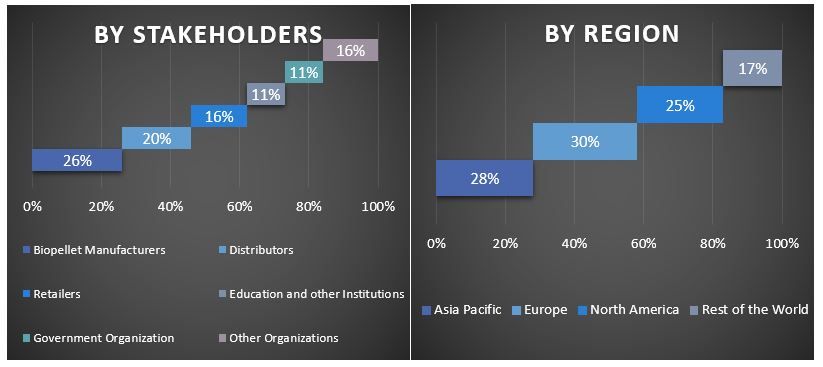
Market Engineering
The data triangulation technique was employed to complete the overall market estimation and to arrive at precise statistical numbers for each segment and sub-segment of the global Biopellet Energy market. data was split into several segments & sub-segments after studying various parameters and trends in the areas of type, application, and end-user in the global Biopellet Energy market.
The main objective of the Global Biopellet Energy Market Study
The current & future market trends of the global Biopellet Energy market were pinpointed in the study. Investors can gain strategic insights to base their discretion for investments on the qualitative and quantitative analysis performed in the study. Current and future market trends determined the overall attractiveness of the market at a regional level, providing a platform for the industrial participant to exploit the untapped market to benefit from a first-mover advantage. Other quantitative goals of the studies include:
- Analyze the current and forecast market size of the Biopellet Energy market in terms of value (USD). Also, analyze the current and forecast market size of different segments and sub-segments.
- Segments in the study include areas of type, application, and end-user.
- Define and analyze the regulatory framework for the Biopellet Energy
- Analyze the value chain involved with the presence of various intermediaries, along with analyzing customer and competitor behaviors of the industry.
- Analyze the current and forecast market size of the Biopellet Energy market for the major region.
- Major countries of regions studied in the report include Asia Pacific, Europe, North America, and the Rest of the World
- Company profile of the Biopellet Energy market and the growth strategies adopted by the market players to sustain in the fast-growing market.
- Deep dive regional level analysis of the industry
Frequently Asked Questions FAQs
Q1: What is the current market size and growth potential of the Biopellet Energy market?
Q2: What are the driving factors for the growth of the Biopellet Energy market?
Q3: Which segment has the largest share of the Biopellet Energy market by type?
Q4: What are the emerging technologies and trends in the Biopellet Energy market?
Q5: Which region will dominate the Biopellet Energy market?
Related Reports
Customers who bought this item also bought










